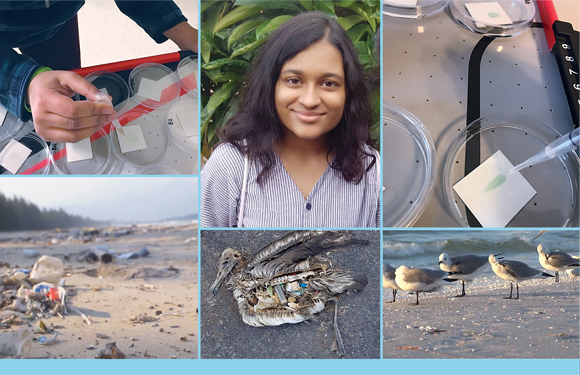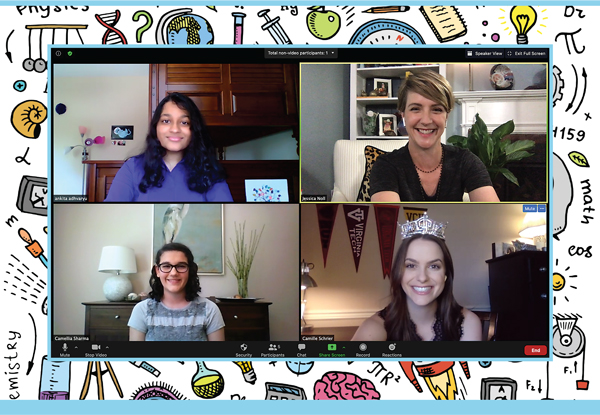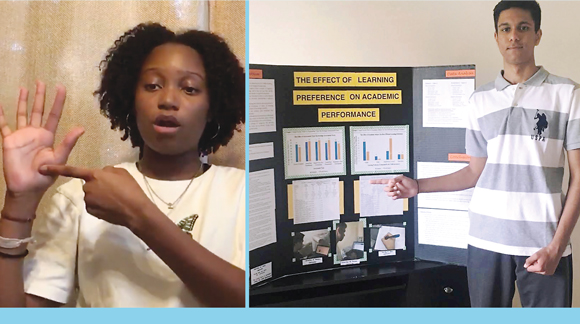Ankita Adhvaryu, a senior at Mills Godwin High School in Henrico, has cultivated a passion for science by spending time experiencing the beauty of nature. This instilled in her a respect for the natural world and helped her develop a new perspective on caring for the environment as a young girl.
“I realized as humans we have been causing all these problems,” says the senior division champion of MEDARVA Healthcare’s inaugural virtual science fair in 2020. “We have been doing this to ourselves. If we are going to cause problems [in the environment], we might as well find ways to fix them.”
Adhvaryu was inspired to conduct her science experiment, “The Effect of Various Environmentally Friendly Algae Deterrents on the Control of Phytoplankton Growth on Plastic,” after she saw distressing images of wildlife online and in print. The carcasses of birds that had choked to death on plastic left on beaches and in parking lots appalled her.
“I thought, ‘I can’t do much as a high school student, but I am going to do what I can,’” she says. “I went down a rabbit hole of research on the Internet.”
She found an article that detailed how phytoplankton (algae) that grows on plastic emits a chemical with a certain smell that is attractive to sea birds. The birds dive toward the algae and while trying to eat it, they also eat the plastic, which can kill them.
“I wanted to find a way to stop that from happening,” she says. “If I can’t stop the birds from eating the plastic, I can try to move algae away from plastic so birds won’t eat it.”
Adhvaryu began looking at various types of environmentally friendly algae deterrents that would keep algae away from plastic. “Then it would have no smell and the birds won’t eat it,” she says, adding that new studies note other marine animals might be attracted to the smell of the same chemical that algae emits. “It’s nice being able to test things out for yourself, as well as read about it.”
She encourages students to not only conduct experiments on their own, but also look at science as a viable career path. “Without science, we don’t exist. Science is one of those things that can give you an in-depth look at the past, present, and future,” she says.
Science helps you understand the world around you and the environment, she adds. “The more people who get curious about this, the more people will grow up to be researchers, chemists, scientists… the next scientific revolution. Life will get better the more we learn.”
Virtual Science Fair to the Rescue
Bruce Kupper, CEO of MEDARVA Healthcare, says the organization introduced its virtual science fair to help cultivate an early interest in research and making new discoveries.
“Since 2005, the MEDARVA Medical Foundation has funded almost $5 million in research efforts at University of Virginia, Virginia Commonwealth University, and Eastern Virginia Medical School. Most of our dollars have gone to researchers who have a kernel of an idea and want to test that idea and parlay that research into other grants,” he says, adding that it seems like research is becoming less of a priority with institutions of higher learning because of busy schedules.
That reality, in conjunction with the pandemic and the emphasis on remote learning, gave MEDARVA the idea to hold a virtual science fair that Kupper hopes will spark natural curiosity and creativity among students interested in the field of science.
“When schools started to shut down last year, we knew kids had started projects for science fairs, and we didn’t want that research to go to waste,” he says. “We decided to do a science fair for the first time. What better way to start off than virtually.”
The organization’s first virtual science fair was a success and received fifty-six submissions from Richmond-area public school, private school, and homeschool students in 2020. Adhvaryu was senior division champion and Camellia Sharma, from George H. Moody Middle School, was junior division champion.
This year’s science fair will accept submissions from April 2 to May 15. First, second, and third place winners in two categories (grades six through eight and nine through twelve) will receive cash awards. Winners will be notified by June 1. The science fair is free and open to Greater Richmond-area students.
Kupper was impressed with all of last year’s projects and experiments, ranging from something as simple as creating and studying slime to studying the resistance of sailing vessels through water. And while only two projects could win the championship, it was evident that each project provided an important learning experience.
The science fair gives young people the opportunity not only to experiment and learn from those experiments, but
also to have the chance to improve their presentation and communication skills. “The purpose of the science fair is to engage kids and let them be creative and learn that experimenting is fun,” Kupper says.
The pandemic is a real-world example of the need for scientific research that finds solutions to problems such as COVID-19, he adds.
“This is a huge health problem that is affecting our daily lives, and young people can see the effect that science is having on the path forward. It’s a cause and effect we can point to,” says Kupper. “If we can get young men and women interested in science and research early, they can see the cause and effect science has on everyday lives.”
Celebrity Science Fair Judge Weighs In
Last year, Camille Schrier took a little time from her duties as Miss America to serve as a judge of the virtual science fair. She will be judging this year’s entries as well.
“These kids are immensely talented and intelligent. These were college-level projects. They followed a method of approach tailored to solving a difficult problem,” says Schrier, a Virginia Tech graduate and VCU School of Pharmacy student who will be returning to VCU in August. “For those of us who experience science from a career perspective, running your own project and coming to your own solution is so relevant to what people in science do.”
Impressed with the science fair entries, Schrier said it was difficult to choose the winners. “It came down to who did the most complete job,” she says. “What stood out was how advanced these students were, how creative they were, their attention to detail, and the fact their scientific projects were above what I expected.”
Schrier was pleased to see the number of young women submitting science projects, as well as the overall diversity of participants and topics within the age groups. “I love it that girls won. I want to see more women in science,” she says. “They didn’t win because they were girls. They won because their projects were the best.”
Public Health, Science, and Remote Learning
Layla Gardner was a freshman at Glen Allen High School when she participated in the 2020 science fair. Inspired by the health and safety measures in the early months of the pandemic, she designed a science project, “to learn about effective sanitization methods to help keep myself and my family safe.”
Her project, “The Effectiveness of Hand Sanitization Methods on the Reduction of Bacteria,” examined effective hand sanitation methods. Gardner tested hand soap, hand sanitizer, a 0.05% bleach solution, dish soap, and a control. Each participant used a different sanitization method.
“Once sanitized, I swabbed their hand. The cotton swab was then swabbed on an agar plate to facilitate bacterial colony growth,” she says.
Gardner’s interest in science stems from the number of healthcare professionals in her family. “As the daughter of a female doctor and granddaughter of a labor and delivery nurse, I have seen firsthand the impact these women were able to make in their communities through hard work and dedication. In my future, I know there will be more women in science, but right now, there are not enough,” she says.
She feels it’s important to strive to comprehend science and maintain a level of curiosity, she says. “For example, with the rollout of the new vaccines, it is healthy to question how they work and if they are safe. Science is driven by curiosity and without it, science would be stagnant,” Gardner says.
Gardner says remote learning has been a challenge for her. “I really took for granted being at school and walking through the hallways with my friends. I struggled to adapt to the absence of a social scene. I found that school was a very social event and without it, I was almost lost.”
The teen says there are some benefits to remote learning as well. “Some of my favorites being a better sleep schedule, more freedom in some aspects, better lunch, and of course, sweatpants.”
Another benefit might be the introduction of events like MEDARVA’s virtual science fair. Students in grades six through twelve from the region will have until May 15 to submit their science fair entries. Visit MEDARVA.com for information and complete rules.







